The Combined Impacts of ENSO and IOD on Global Seasonal Droughts
Abstract
1. Introduction
2. Data and Methods
2.1. Precipitation and SST Data
2.2. ENSO and IOD Indices
2.3. Identification of Large-Scale Drought Events
2.4. Causal Analysis between ENSO/IOD and SPI3
2.5. Metrics
3. Results
3.1. Global Drought during ENSO Events
3.1.1. The Proportion of Global Droughts during Different ENSO Types
3.1.2. The Significant Drought Timing and Duration in Climate Reference Regions
3.2. Global Drought during Combined El Niño and pIOD Events
3.3. Composite Analysis of Vertical Velocity Anomalies
3.4. Causal Analysis between Nino3.4/Nino3/Nino4/DMI and SPI3
4. Conclusions
Author Contributions
Funding
Institutional Review Board Statement
Informed Consent Statement
Conflicts of Interest
Appendix A
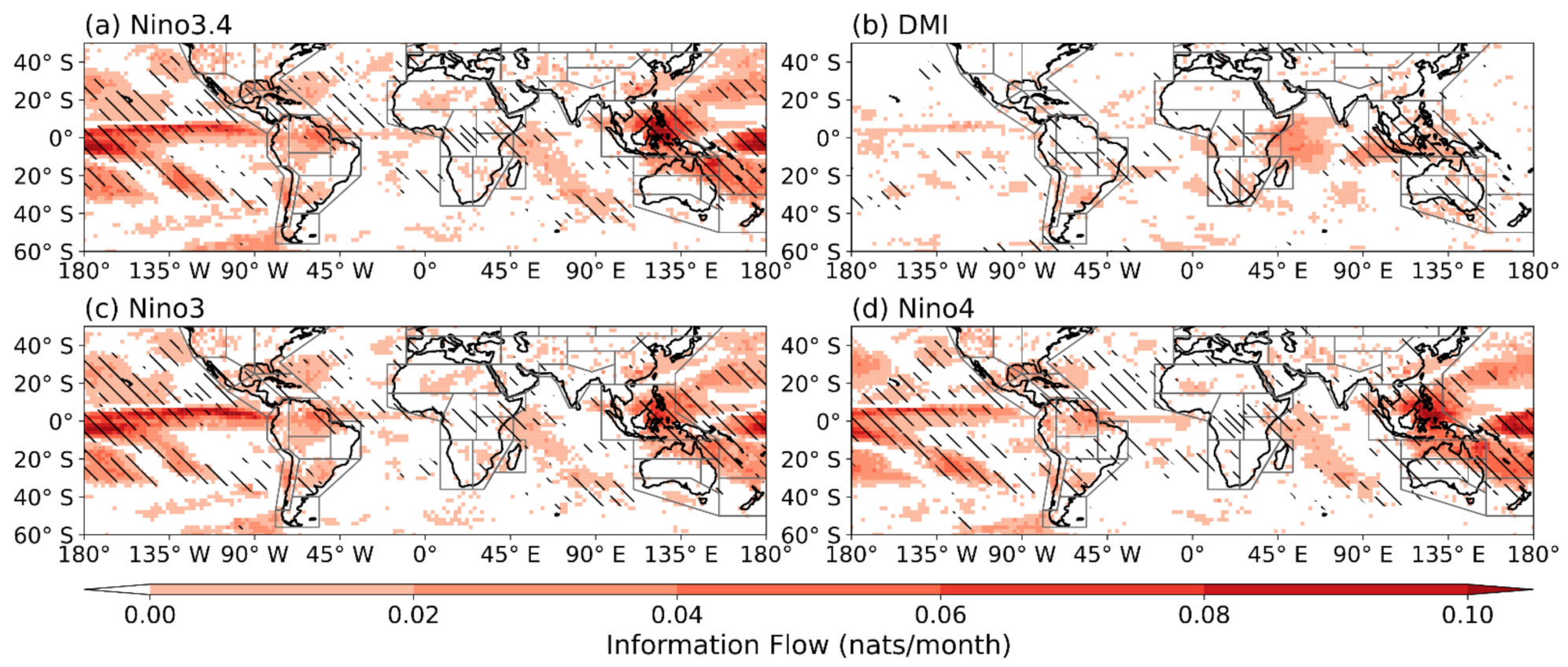
References
- Liu, Z.; Törnros, T.; Menzel, L. A probabilistic prediction network for hydrological drought identification and environmental flow assessment. Water Resour. Res. 2016, 52, 6243–6262. [Google Scholar] [CrossRef]
- Nations, U. World ‘at a Crossroads’ as Droughts Increase Nearly a Third in a Generation. Available online: https://news.un.org/en/story/2022/05/1118142 (accessed on 12 May 2022).
- Dai, A. Drought under global warming: A review. Wiley Interdiscip. Rev. Clim. Chang. 2011, 2, 45–65. [Google Scholar] [CrossRef]
- Sheffield, J.; Wood, E.F.; Roderick, M.L. Little change in global drought over the past 60 years. Nature 2012, 491, 435–438. [Google Scholar] [CrossRef] [PubMed]
- Trenberth, K.E.; Dai, A.; Van Der Schrier, G.; Jones, P.D.; Barichivich, J.; Briffa, K.R.; Sheffield, J. Global warming and changes in drought. Nat. Clim. Chang. 2014, 4, 17–22. [Google Scholar] [CrossRef]
- McCabe, G.J.; Wolock, D.M. Variability and trends in global drought. Earth Space Sci. 2015, 2, 223–228. [Google Scholar] [CrossRef]
- Herrera-Estrada, J.E.; Satoh, Y.; Sheffield, J. Spatiotemporal dynamics of global drought. Geophys. Res. Lett. 2017, 44, 2254–2263. [Google Scholar] [CrossRef]
- Hao, Z.; Hao, F.; Singh, V.P.; Zhang, X. Changes in the severity of compound drought and hot extremes over global land areas. Environ. Res. Lett. 2018, 13, 124022. [Google Scholar] [CrossRef]
- Wilhite, D.A.; Glantz, M.H. Understanding: The drought phenomenon: The role of definitions. Water Int. 1985, 10, 111–120. [Google Scholar] [CrossRef]
- Hao, Z.; Singh, V.P.; Xia, Y. Seasonal drought prediction: Advances, challenges, and future prospects. Rev. Geophys. 2018, 56, 108–141. [Google Scholar] [CrossRef]
- National Drought Mitigation Center. Types of Drought. Available online: https://drought.unl.edu/Education/DroughtIn-depth/TypesofDrought.aspx (accessed on 29 August 2022).
- Hao, Z.; Hao, F.; Singh, V.P.; Zhang, X. Quantifying the relationship between compound dry and hot events and El Niño–southern Oscillation (ENSO) at the global scale. J. Hydrol. 2018, 567, 332–338. [Google Scholar] [CrossRef]
- Hobbins, M.T.; Dai, A.; Roderick, M.L.; Farquhar, G.D. Revisiting the parameterization of potential evaporation as a driver of long-term water balance trends. Geophys. Res. Lett. 2008, 35. [Google Scholar] [CrossRef]
- Sun, S.; Chen, H.; Wang, G.; Li, J.; Mu, M.; Yan, G.; Xu, B.; Huang, J.; Wang, J.; Zhang, F. Shift in potential evapotranspiration and its implications for dryness/wetness over Southwest China. J. Geophys. Res. Atmos. 2016, 121, 9342–9355. [Google Scholar] [CrossRef]
- Zscheischler, J.; Seneviratne, S.I. Dependence of drivers affects risks associated with compound events. Sci. Adv. 2017, 3, e1700263. [Google Scholar] [CrossRef]
- Miralles, D.G.; Gentine, P.; Seneviratne, S.I.; Teuling, A.J. Land–atmospheric feedbacks during droughts and heatwaves: State of the science and current challenges. Ann. N. Y. Acad. Sci. 2019, 1436, 19–35. [Google Scholar] [CrossRef]
- Zhou, S.; Williams, A.P.; Berg, A.M.; Cook, B.I.; Zhang, Y.; Hagemann, S.; Lorenz, R.; Seneviratne, S.I.; Gentine, P. Land–atmosphere feedbacks exacerbate concurrent soil drought and atmospheric aridity. Proc. Natl. Acad. Sci. USA 2019, 116, 18848–18853. [Google Scholar] [CrossRef]
- Nguyen, P.L.; Min, S.K.; Kim, Y.H. Combined impacts of the El Niño-Southern Oscillation and Pacific decadal oscillation on global droughts assessed using the standardized precipitation evapotranspiration index. Int. J. Climatol. 2021, 41, E1645–E1662. [Google Scholar] [CrossRef]
- Chen, P.; Newman, M. Rossby wave propagation and the rapid development of upper-level anomalous anticyclones during the 1988 US drought. J. Clim. 1998, 11, 2491–2504. [Google Scholar] [CrossRef]
- Jin, D.; Guan, Z.; Tang, W. The Extreme Drought Event during Winter–Spring of 2011 in East China: Combined Influences of Teleconnection in Midhigh Latitudes and Thermal Forcing in Maritime Continent Region. J. Clim. 2013, 26, 8210–8222. [Google Scholar] [CrossRef]
- Lhotka, O.; Trnka, M.; Kyselý, J.; Markonis, Y.; Balek, J.; Možný, M. Atmospheric circulation as a factor contributing to increasing drought severity in central Europe. J. Geophys. Res. Atmos. 2020, 125, e2019JD032269. [Google Scholar] [CrossRef]
- Hamal, K.; Sharma, S.; Pokharel, B.; Shrestha, D.; Talchabhadel, R.; Shrestha, A.; Khadka, N. Changing pattern of drought in Nepal and associated atmospheric circulation. Atmos. Res. 2021, 262, 105798. [Google Scholar] [CrossRef]
- Rodrigues, R.R.; Taschetto, A.S.; Sen Gupta, A.; Foltz, G.R. Common cause for severe droughts in South America and marine heatwaves in the South Atlantic. Nat. Geosci. 2019, 12, 620–626. [Google Scholar] [CrossRef]
- Chikoore, H.; Jury, M.R. South African drought, deconstructed. Weather. Clim. Extrem. 2021, 33, 100334. [Google Scholar] [CrossRef]
- Lenssen, N.J.L.; Goddard, L.; Mason, S. Seasonal Forecast Skill of ENSO Teleconnection Maps. Weather Forecast. 2020, 35, 2387–2406. [Google Scholar] [CrossRef]
- Christian, J.I.; Basara, J.B.; Hunt, E.D.; Otkin, J.A.; Furtado, J.C.; Mishra, V.; Xiao, X.; Randall, R.M. Global distribution, trends, and drivers of flash drought occurrence. Nat. Commun. 2021, 12, 6330. [Google Scholar] [CrossRef]
- Zhang, W.; Jin, F.F.; Turner, A. Increasing autumn drought over southern China associated with ENSO regime shift. Geophys. Res. Lett. 2014, 41, 4020–4026. [Google Scholar] [CrossRef]
- Freund, M.B.; Marshall, A.G.; Wheeler, M.C.; Brown, J.N. Central Pacific El Niño as a precursor to summer drought-breaking rainfall over southeastern Australia. Geophys. Res. Lett. 2021, 48, e2020GL091131. [Google Scholar] [CrossRef]
- Yu, J.-Y.; Zou, Y. The enhanced drying effect of Central-Pacific El Niño on US winter. Environ. Res. Lett. 2013, 8, 014019. [Google Scholar] [CrossRef]
- Chen, M.; Yu, J.Y.; Wang, X.; Chen, S. Distinct onset mechanisms of two subtypes of CP El Niño and their changes in future warming. Geophys. Res. Lett. 2021, 48, e2021GL093707. [Google Scholar] [CrossRef]
- Freund, M.; Henley, B.; Karoly, D.; McGregor, H.; Abram, N.; Dommenget, D. Higher frequency of Central Pacific El Niño events in recent decades relative to past centuries. Nat. Geosci. 2019, 12, 450–455. [Google Scholar] [CrossRef]
- Wang, B.; Luo, X.; Yang, Y.-M.; Sun, W.; Cane, M.A.; Cai, W.; Yeh, S.-W.; Liu, J. Historical change of El Niño properties sheds light on future changes of extreme El Niño. Proc. Natl. Acad. Sci. USA 2019, 116, 22512–22517. [Google Scholar] [CrossRef]
- Lyon, B. The strength of El Niño and the spatial extent of tropical drought. Geophys. Res. Lett. 2004, 31, L21204. [Google Scholar] [CrossRef]
- Wang, S.; Yuan, X.; Li, Y. Does a Strong El Niño Imply a Higher Predictability of Extreme Drought? Sci. Rep. 2017, 7, 40741. [Google Scholar] [CrossRef] [PubMed]
- Truchelut, R.E.; Staehling, E.M. An energetic perspective on United States tropical cyclone landfall droughts. Geophys. Res. Lett. 2017, 44, 12–013. [Google Scholar] [CrossRef]
- Herrera-Estrada, J.E.; Diffenbaugh, N.S. Landfalling Droughts: Global tracking of moisture deficits from the oceans onto land. Water Resour. Res. 2020, 56, e2019WR026877. [Google Scholar] [CrossRef]
- Yue, Z.; Zhou, W.; Li, T. Impact of the Indian Ocean Dipole on Evolution of the Subsequent ENSO: Relative Roles of Dynamic and Thermodynamic Processes. J. Clim. 2021, 34, 3591–3607. [Google Scholar] [CrossRef]
- Cai, W.; Sullivan, A.; Cowan, T. Interactions of ENSO, the IOD, and the SAM in CMIP3 Models. J. Clim. 2011, 24, 1688–1704. [Google Scholar] [CrossRef]
- Cai, W.; Wu, L.; Lengaigne, M.; Li, T.; McGregor, S.; Kug, J.-S.; Yu, J.-Y.; Stuecker, M.F.; Santoso, A.; Li, X.; et al. Pantropical climate interactions. Science 2019, 363, eaav4236. [Google Scholar] [CrossRef]
- Lestari, R.K.; Koh, T.-Y. Statistical Evidence for Asymmetry in ENSO–IOD Interactions. Atmos.-Ocean. 2016, 54, 498–504. [Google Scholar] [CrossRef]
- GFDL Global Atmospheric Model Development Team; Anderson, J.L.; Balaji, V.; Broccoli, A.J.; Cooke, W.F.; Delworth, T.L.; Dixon, K.W.; Donner, L.J.; Dunne, K.A.; Freidenreich, S.M. The new GFDL global atmosphere and land model AM2–LM2: Evaluation with prescribed SST simulations. J. Clim. 2004, 17, 4641–4673. [Google Scholar]
- Zhang, W.; Mao, W.; Jiang, F.; Stuecker, M.F.; Jin, F.F.; Qi, L. Tropical Indo-Pacific compounding thermal conditions drive the 2019 Australian extreme drought. Geophys. Res. Lett. 2021, 48, e2020GL090323. [Google Scholar] [CrossRef]
- Neale, R.B.; Chen, C.-C.; Gettelman, A.; Lauritzen, P.H.; Park, S.; Williamson, D.L.; Conley, A.J.; Garcia, R.; Kinnison, D.; Lamarque, J.-F. Description of the NCAR community atmosphere model (CAM 5.0). NCAR Tech. Note NCAR/TN-486+STR 2010, 1, 1–12. [Google Scholar]
- Xu, K.; Miao, H.Y.; Liu, B.; Tam, C.Y.; Wang, W. Aggravation of record-breaking drought over the mid-to-lower reaches of the Yangtze River in the post-monsoon season of 2019 by anomalous Indo-Pacific oceanic conditions. Geophys. Res. Lett. 2020, 47, e2020GL090847. [Google Scholar] [CrossRef]
- Chen, X.; Wang, S.; Hu, Z.; Zhou, Q.; Hu, Q. Spatiotemporal characteristics of seasonal precipitation and their relationships with ENSO in Central Asia during 1901–2013. J. Geogr. Sci. 2018, 28, 1341–1368. [Google Scholar] [CrossRef]
- Liu, Z.; Menzel, L.; Dong, C.; Fang, R. Temporal dynamics and spatial patterns of drought and the relation to ENSO: A case study in Northwest China. Int. J. Climatol. 2016, 36, 2886–2898. [Google Scholar] [CrossRef]
- Ni, S.; Chen, J.; Wilson, C.R.; Li, J.; Hu, X.; Fu, R. Global Terrestrial Water Storage Changes and Connections to ENSO Events. Surv. Geophys. 2018, 39, 1–22. [Google Scholar] [CrossRef]
- Buchanan, M. Cause and correlation. Nat. Phys. 2012, 8, 852. [Google Scholar] [CrossRef]
- Liang, X.S. The Liang-Kleeman information flow: Theory and applications. Entropy 2013, 15, 327–360. [Google Scholar] [CrossRef]
- Liang, X.S. Unraveling the cause-effect relation between time series. Phys. Rev. E 2014, 90, 052150. [Google Scholar] [CrossRef]
- San Liang, X. Normalizing the causality between time series. Phys. Rev. E 2015, 92, 022126. [Google Scholar] [CrossRef]
- Endris, H.S.; Lennard, C.; Hewitson, B.; Dosio, A.; Nikulin, G.; Artan, G.A. Future changes in rainfall associated with ENSO, IOD and changes in the mean state over Eastern Africa. Clim. Dyn. 2019, 52, 2029–2053. [Google Scholar] [CrossRef]
- Xiao, H.-M.; Lo, M.-H.; Yu, J.-Y. The increased frequency of combined El Niño and positive IOD events since 1965s and its impacts on maritime continent hydroclimates. Sci. Rep. 2022, 12, 7532. [Google Scholar] [CrossRef]
- Gebrechorkos, S.H.; Hülsmann, S.; Bernhofer, C. Analysis of climate variability and droughts in East Africa using high-resolution climate data products. Glob. Planet. Chang. 2020, 186, 103130. [Google Scholar] [CrossRef]
- Shah, D.; Mishra, V. Drought onset and termination in India. J. Geophys. Res. Atmos. 2020, 125, e2020JD032871. [Google Scholar] [CrossRef]
- Hu, C.; Lian, T.; Cheung, H.-N.; Qiao, S.; Li, Z.; Deng, K.; Yang, S.; Chen, D. Mixed diversity of shifting IOD and El Niño dominates the location of Maritime Continent autumn drought. Natl. Sci. Rev. 2020, 7, 1150–1153. [Google Scholar] [CrossRef]
- Iturbide, M.; Gutiérrez, J.M.; Alves, L.M.; Bedia, J.; Cerezo-Mota, R.; Cimadevilla, E.; Cofiño, A.S.; Di Luca, A.; Faria, S.H.; Gorodetskaya, I.V. An update of IPCC climate reference regions for subcontinental analysis of climate model data: Definition and aggregated datasets. Earth Syst. Sci. Data 2020, 12, 2959–2970. [Google Scholar] [CrossRef]
- Ren, H.-L.; Lu, B.; Wan, J.; Tian, B.; Zhang, P. Identification Standard for ENSO Events and Its Application to Climate Monitoring and Prediction in China. J. Meteorol. Res. 2018, 32, 923–936. [Google Scholar] [CrossRef]
- Saji, N.H.; Goswami, B.N.; Vinayachandran, P.N.; Yamagata, T. A dipole mode in the tropical Indian Ocean. Nature 1999, 401, 360–363. [Google Scholar] [CrossRef]
- Hameed, S.; Yamagata, T. Possible impacts of Indian Ocean Dipole Mode events on global climate. Clim. Res. 2003, 25, 151–169. [Google Scholar] [CrossRef]
- World Meteorological Organization (WMO): Standardized Precipitation Index User Guide, Geneva, Switzerland. Available online: http://www.wamis.org/agm/pubs/SPI/WMO_1090_EN.pdf (accessed on 20 November 2017).
- Dutra, E.; Pozzi, W.; Wetterhall, F.; Di Giuseppe, F.; Magnusson, L.; Naumann, G.; Barbosa, P.; Vogt, J.; Pappenberger, F. Global meteorological drought–Part 2: Seasonal forecasts. Hydrol. Earth Syst. Sci. 2014, 18, 2669–2678. [Google Scholar] [CrossRef]
- Liu, Z.; Lu, G.; He, H.; Wu, Z.; He, J. Understanding Atmospheric Anomalies Associated With Seasonal Pluvial-Drought Processes Using Southwest China as an Example. J. Geophys. Res. Atmos. 2017, 122, 12–210. [Google Scholar] [CrossRef]
- Liu, Z.; Zhou, W. The 2019 Autumn Hot Drought Over the Middle-Lower Reaches of the Yangtze River in China: Early Propagation, Process Evolution, and Concurrence. J. Geophys. Res. Atmos. 2021, 126, e2020JD033742. [Google Scholar] [CrossRef]
- McKee, T.B.; Doesken, N.J.; Kleist, J. The relationship of drought frequency and duration to time scales. In Proceedings of the 8th Conference on Applied Climatology, Boston, MA, USA, 17–22 January 1993; pp. 179–183. [Google Scholar]
- Adams, J. Climate_Indices, an Open Source Python Library Providing Reference Implementations of Commonly Used Climate Indices. Available online: https://github.com/monocongo/climate_indices (accessed on 1 May 2017).
- Andreadis, K.M.; Clark, E.A.; Wood, A.W.; Hamlet, A.F.; Lettenmaier, D.P. Twentieth-century drought in the conterminous United States. J. Hydrometeorol. 2005, 6, 985–1001. [Google Scholar] [CrossRef]
- He, X.; Pan, M.; Wei, Z.; Wood, E.F.; Sheffield, J. A global drought and flood catalogue from 1950 to 2016. Bull. Am. Meteorol. Soc. 2020, 101, E508–E535. [Google Scholar] [CrossRef]
- Sheffield, J.; Andreadis, K.M.; Wood, E.F.; Lettenmaier, D.P. Global and continental drought in the second half of the twentieth century: Severity–area–duration analysis and temporal variability of large-scale events. J. Clim. 2009, 22, 1962–1981. [Google Scholar] [CrossRef]
- Zhan, W.; Guan, K.; Sheffield, J.; Wood, E.F. Depiction of drought over sub-Saharan Africa using reanalyses precipitation data sets. J. Geophys. Res. Atmos. 2016, 121, 10–555. [Google Scholar] [CrossRef]
- Tian, L.; Zhang, B.; Wu, P. A global drought dataset of standardized moisture anomaly index incorporating snow dynamics (SZI snow) and its application in identifying large-scale drought events. Earth Syst. Sci. Data 2022, 14, 2259–2278. [Google Scholar] [CrossRef]
- Stips, A.; Macias, D.; Coughlan, C.; Garcia-Gorriz, E.; Liang, X.S. On the causal structure between CO2 and global temperature. Sci. Rep. 2016, 6, 1–9. [Google Scholar] [CrossRef]
- Wikipedia. Nat (Unit). Available online: https://en.wikipedia.org/wiki/Nat_(unit)#cite_note-IEC_80000-13:2008-1 (accessed on 3 November 2005).
- San Liang, X. Information flow and causality as rigorous notions ab initio. Phys. Rev. E 2016, 94, 052201. [Google Scholar] [CrossRef]
- L’Heureux, M.L.; Tippett, M.K.; Barnston, A.G. Characterizing ENSO coupled variability and its impact on North American seasonal precipitation and temperature. J. Clim. 2015, 28, 4231–4245. [Google Scholar] [CrossRef]
- Xiao, M.; Zhang, Q.; Singh, V.P. Influences of ENSO, NAO, IOD and PDO on seasonal precipitation regimes in the Yangtze River basin, China. Int. J. Climatol. 2015, 35, 3556–3567. [Google Scholar] [CrossRef]
- Zhao, T.; Chen, H.; Pan, B.; Ye, L.; Cai, H.; Zhang, Y.; Chen, X. Correspondence relationship between ENSO teleconnection and anomaly correlation for GCM seasonal precipitation forecasts. Clim. Dyn. 2022, 58, 633–649. [Google Scholar] [CrossRef]
- Polonsky, A.; Torbinsky, A. The IOD–ENSO Interaction: The Role of the Indian Ocean Current’s System. Atmosphere 2021, 12, 1662. [Google Scholar] [CrossRef]
- Vicente-Serrano, S.M.; Aguilar, E.; Martínez, R.; Martín-Hernández, N.; Azorin-Molina, C.; Sanchez-Lorenzo, A.; El Kenawy, A.; Tomás-Burguera, M.; Moran-Tejeda, E.; López-Moreno, J.I.; et al. The complex influence of ENSO on droughts in Ecuador. Clim. Dyn. 2017, 48, 405–427. [Google Scholar] [CrossRef]
- Hua, W.; Zhou, L.; Chen, H.; Nicholson, S.E.; Jiang, Y.; Raghavendra, A. Understanding the Central Equatorial African long-term drought using AMIP-type simulations. Clim. Dyn. 2018, 50, 1115–1128. [Google Scholar] [CrossRef]
- Libanda, B.; Zheng, M.; Ngonga, C. Spatial and temporal patterns of drought in Zambia. J. Arid Land 2019, 11, 180–191. [Google Scholar] [CrossRef]
- Liu, Z.; He, H.; Wu, Z.; Lu, G.; Yin, H. The Standardized Vertical Velocity Anomaly Index (SVVAI): Using Atmospheric Dynamical Anomalies to Simulate and Predict Meteorological Droughts. Earth Syst. Dyn. Discuss. 2020, 1–28. [Google Scholar] [CrossRef]
- Liu, Z.; Zhou, W.; Zhang, R.; Zhang, Y.; Wang, Y. Global-scale Interpretable Drought Reconstruction Utilizing Anomalies of Atmospheric Dynamics. J. Hydrometeorol. 2022, 23, 1507–1524. [Google Scholar] [CrossRef]
- Tian, B.; Fan, K. New downscaling prediction models for spring drought in China. Int. J. Climatol. 2022. [CrossRef]
- Pan, M.; Lu, M. A novel atmospheric river identification algorithm. Water Resource. Res. 2019, 55, 6069–6087. [Google Scholar] [CrossRef]
- Pan, M.; Lu, M. East Asia atmospheric river catalog: Annual cycle, transition mechanism, and precipitation. Geophys. Res. Lett. 2020, 47, e2020GL089477. [Google Scholar] [CrossRef]
- Zhang, Y.; Zhou, W.; Wang, X.; Wang, X.; Zhang, R.; Li, Y.; Gan, J. IOD, ENSO, and seasonal precipitation variation over Eastern China. Atmos. Res. 2022, 270, 106042. [Google Scholar] [CrossRef]
- Zhang, Y.; Hao, Z.; Feng, S.; Zhang, X.; Xu, Y.; Hao, F. Agricultural drought prediction in China based on drought propagation and large-scale drivers. Agric. Water Manag. 2021, 255, 107028. [Google Scholar] [CrossRef]
- Manatsa, D.; Mushore, T.; Lenouo, A. Improved predictability of droughts over southern Africa using the standardized precipitation evapotranspiration index and ENSO. Theor. Appl. Climatol. 2017, 127, 259–274. [Google Scholar] [CrossRef]
- Deng, S.; Cheng, L.; Yang, K.; Chen, Y.; Gao, Y.; Yang, N.; Li, M. A multi-scalar evaluation of differential impacts of canonical ENSO and ENSO Modoki on drought in China. Int. J. Climatol. 2019, 39, 1985–2004. [Google Scholar] [CrossRef]
- Ham, Y.-G.; Kim, J.-H.; Luo, J.-J. Deep learning for multi-year ENSO forecasts. Nature 2019, 573, 568–572. [Google Scholar] [CrossRef]
- Wang, L.; Ren, H.-L.; Zhu, J.; Huang, B. Improving prediction of two ENSO types using a multi-model ensemble based on stepwise pattern projection model. Clim. Dyn. 2020, 54, 3229–3243. [Google Scholar] [CrossRef]
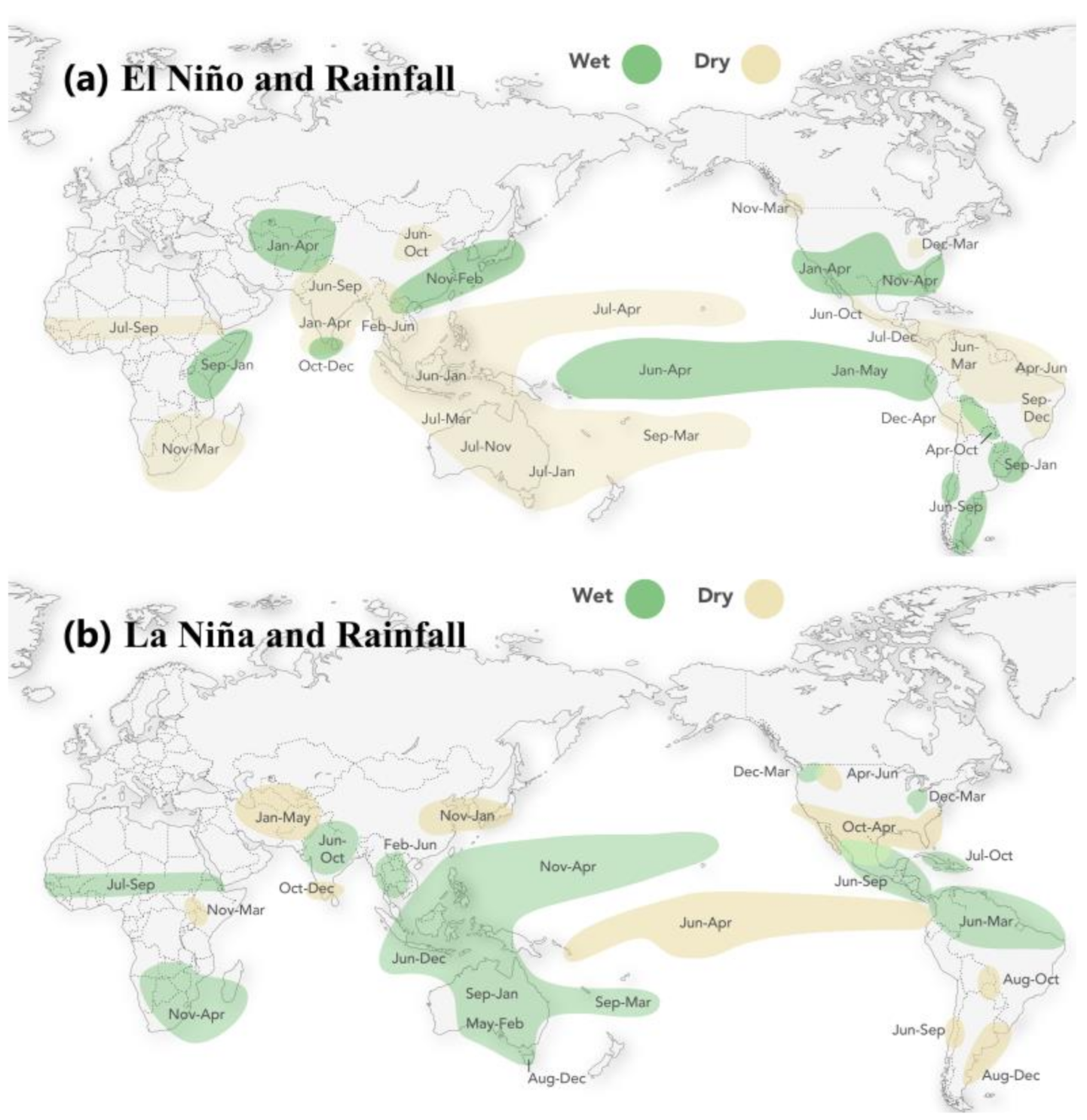
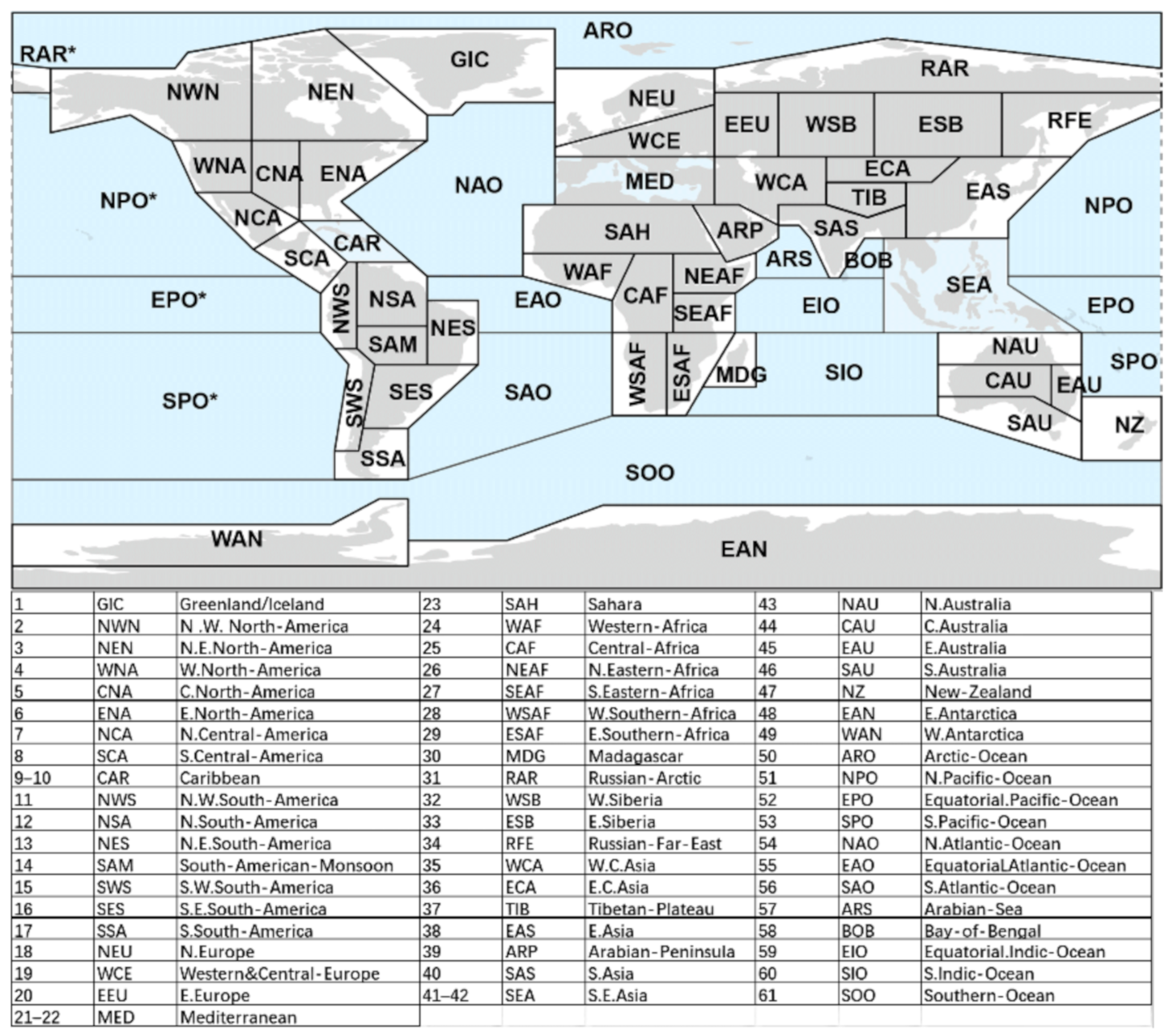



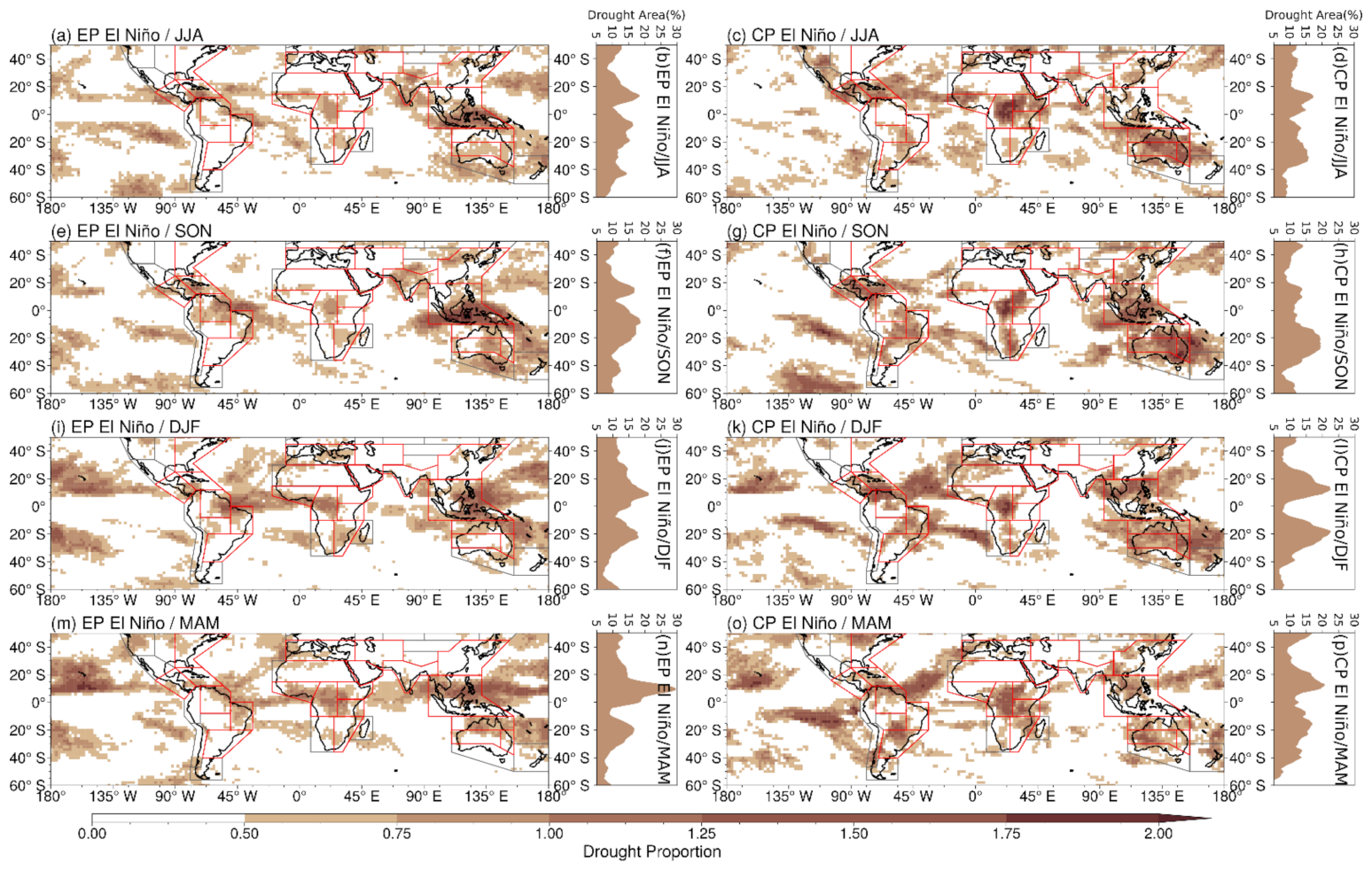
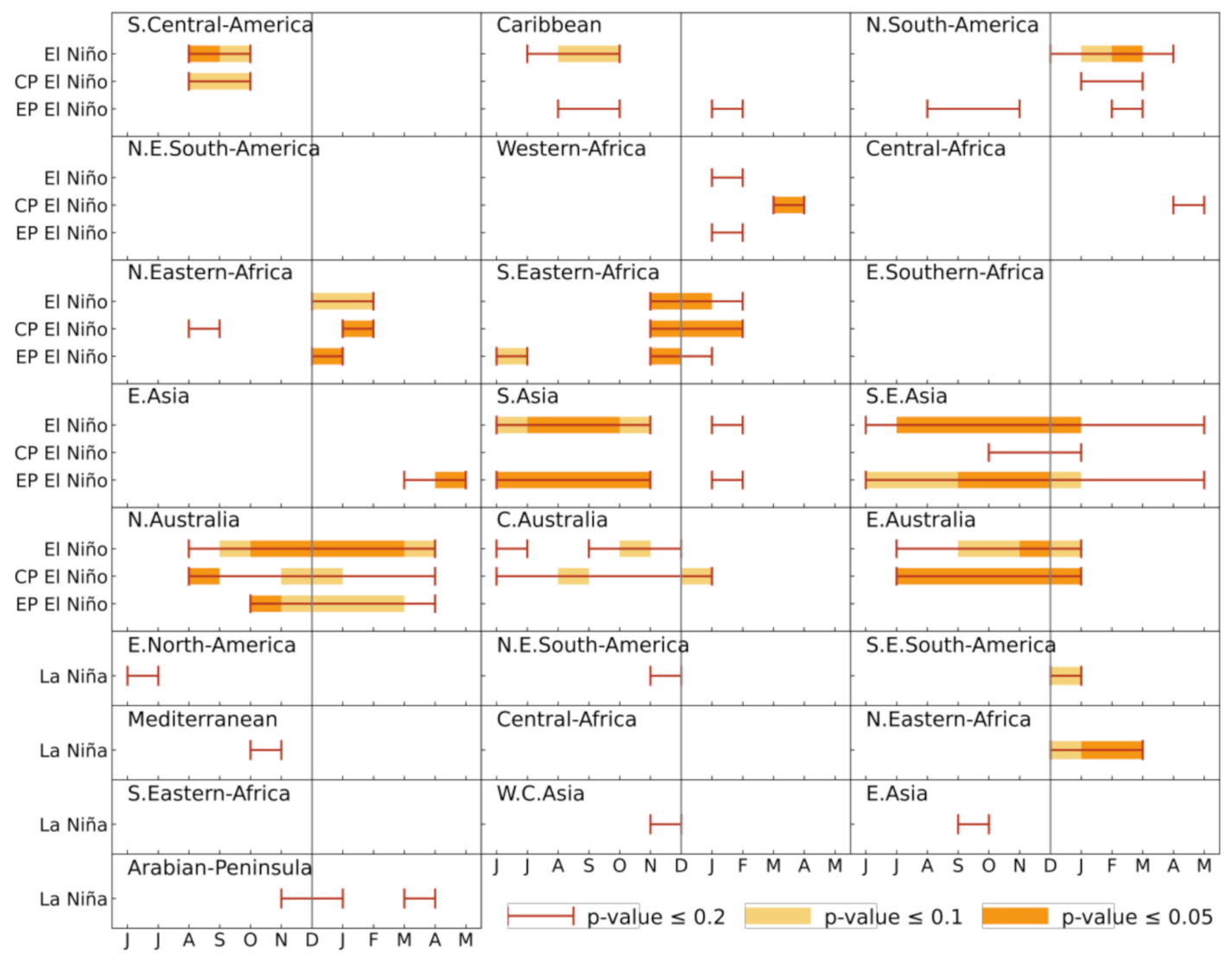
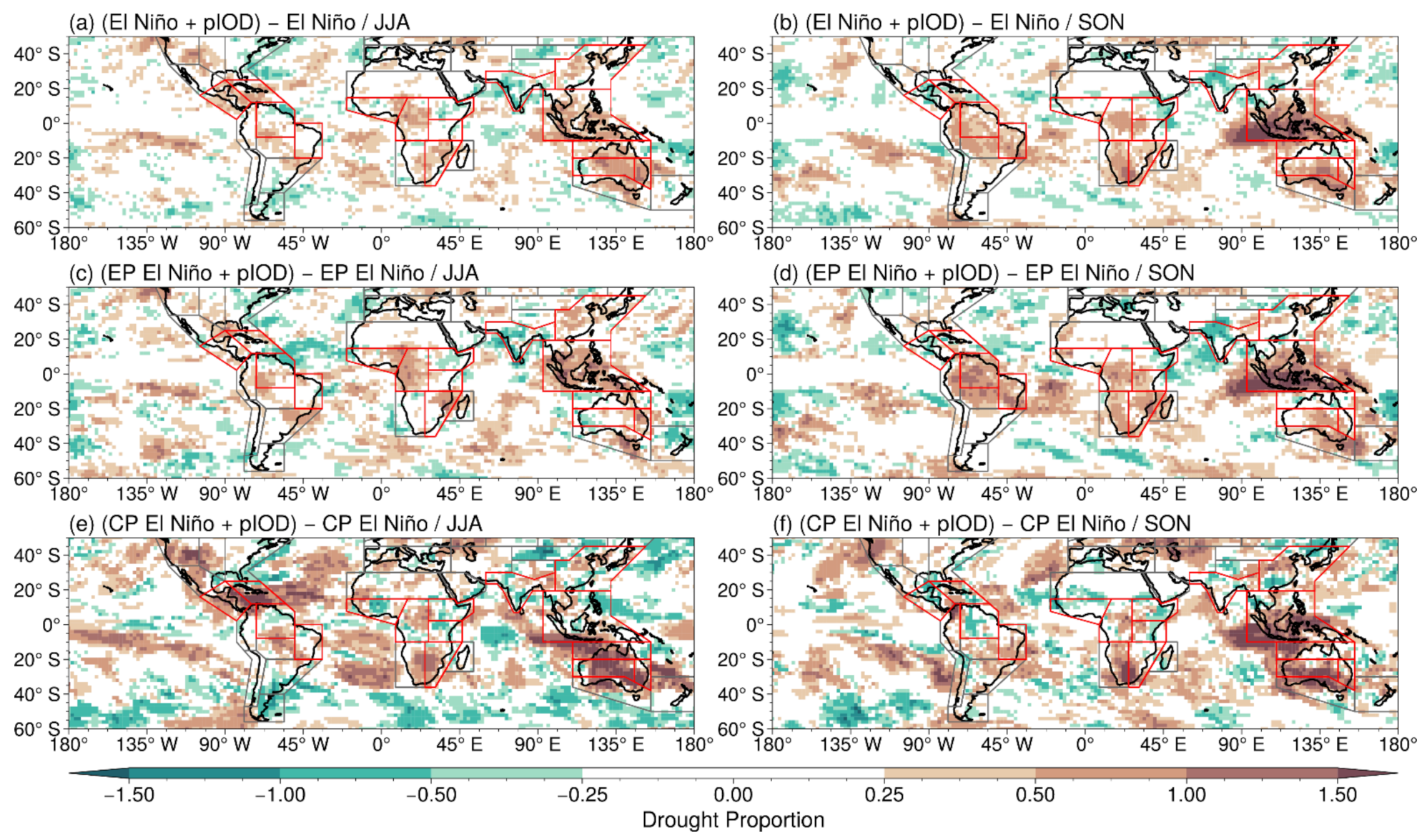
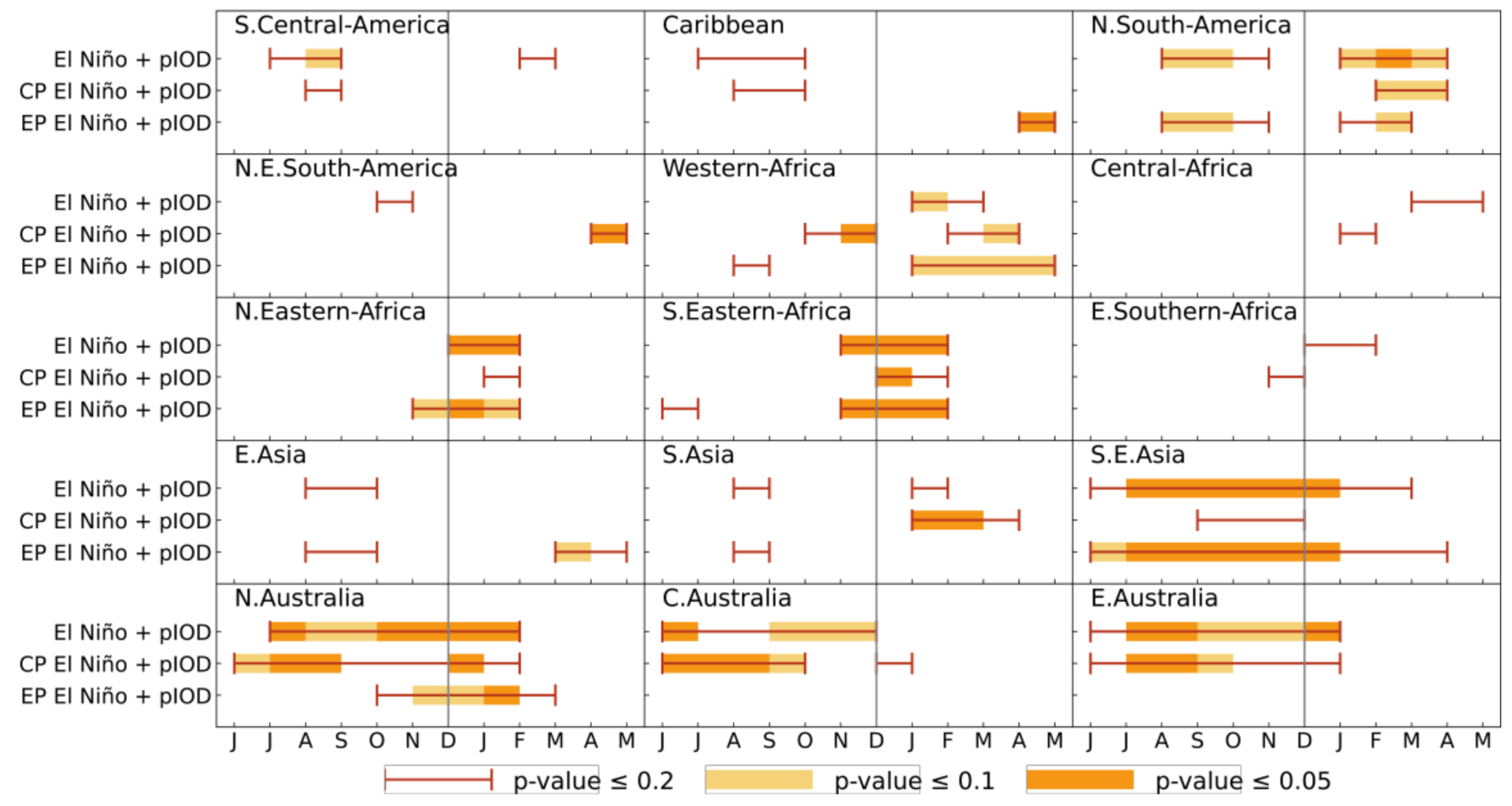

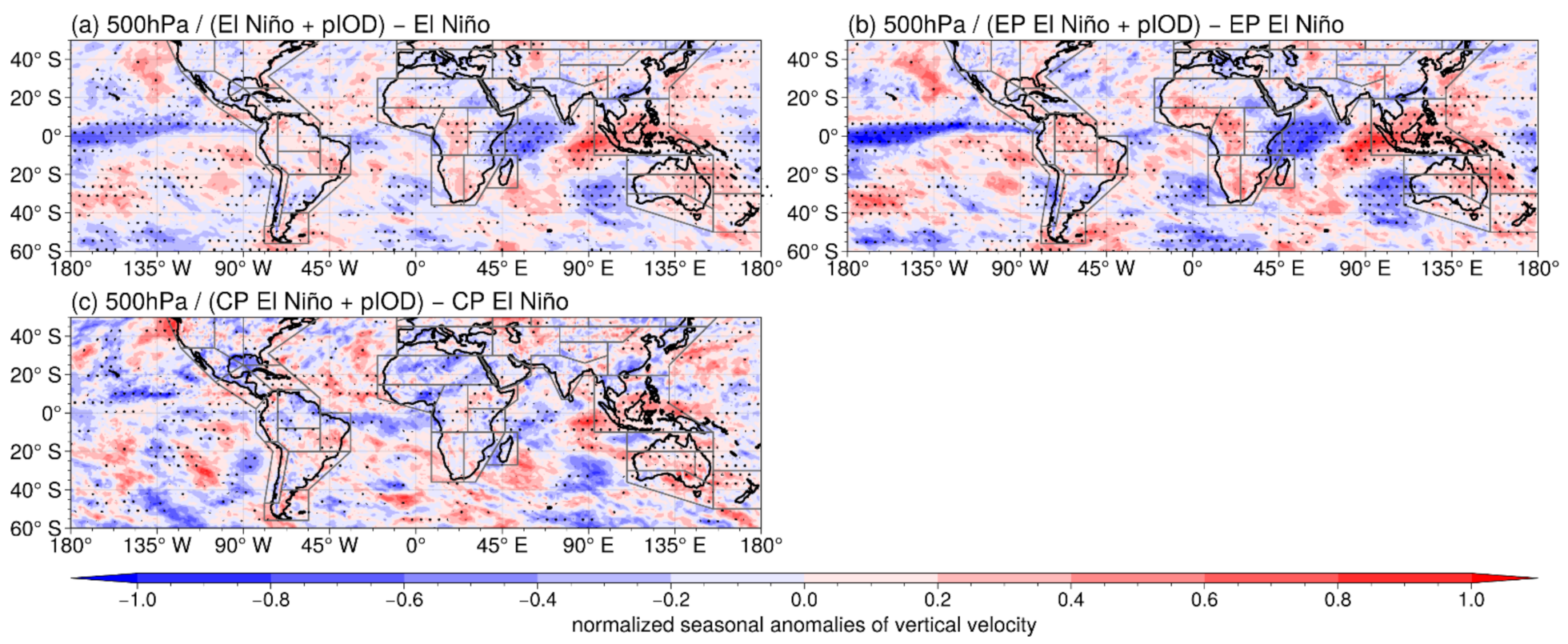
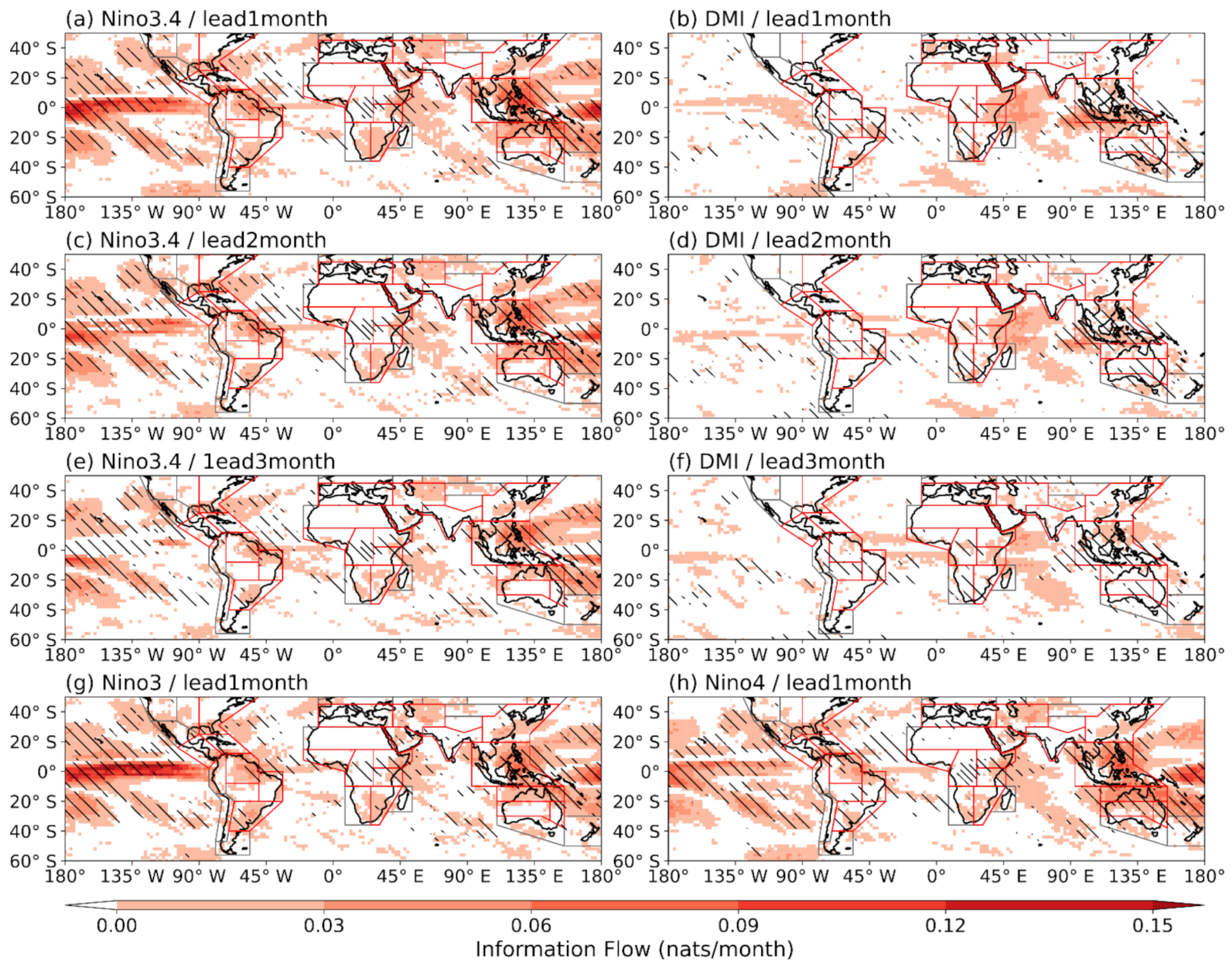

| El Niño | La Niña | IOD | ||
|---|---|---|---|---|
| EP El Niño | CP El Niño | pIOD | nIOD | |
| 1951/1952, 1957/1958, 1963/1964, 1965/1966, 1969/1970, 1972/1973, 1976/1977, 1979/1980, 1982/1983, 1986/1987, 1987/1988, 1991/1992, 1997/1998, 2006/2007, 2014/2015, 2015/2016, | 1968/1969, 1977/1978, 1994/1995, 2002/2003, 2004/2005, 2009/2010, 2018/2019, 2019/2020, | 1954/1955, 1955/1956, 1956/1957, 1964/1965, 1970/1971, 1971/1972, 1973/1974, 1975/1976, 1983/1984, 1984/1985, 1988/1989, 1998/1999, 1999/2000, 2007/2008, 2010/2011, 2011/2012, 2017/2018 | 1951, 1961, 1963, 1972, 1982, 1994, 1997, 2002, 2006, 2011, 2015, 2017, 2018,2019 | 1954, 1957, 1958, 1959, 1960, 1996, 1998 |
| EP El Niño + pIOD | CP El Niño + pIOD | EP El Niño + nIOD | La Niña + pIOD | La Niña + nIOD |
|---|---|---|---|---|
| 1951/1952, 1963/1964, 1972/1973, 1982/1983, 1997/1998, 2006/2007, 2015/2016 | 1994/1995, 2002/2003, 2018/2019, 2019/2020 | 1957/1958 | 2011/2012, 2017/2018 | 1954/1955, 1998/1999 |
Publisher’s Note: MDPI stays neutral with regard to jurisdictional claims in published maps and institutional affiliations. |
© 2022 by the authors. Licensee MDPI, Basel, Switzerland. This article is an open access article distributed under the terms and conditions of the Creative Commons Attribution (CC BY) license (https://creativecommons.org/licenses/by/4.0/).
Share and Cite
Yin, H.; Wu, Z.; Fowler, H.J.; Blenkinsop, S.; He, H.; Li, Y. The Combined Impacts of ENSO and IOD on Global Seasonal Droughts. Atmosphere 2022, 13, 1673. https://doi.org/10.3390/atmos13101673
Yin H, Wu Z, Fowler HJ, Blenkinsop S, He H, Li Y. The Combined Impacts of ENSO and IOD on Global Seasonal Droughts. Atmosphere. 2022; 13(10):1673. https://doi.org/10.3390/atmos13101673
Chicago/Turabian StyleYin, Hao, Zhiyong Wu, Hayley J. Fowler, Stephen Blenkinsop, Hai He, and Yuan Li. 2022. "The Combined Impacts of ENSO and IOD on Global Seasonal Droughts" Atmosphere 13, no. 10: 1673. https://doi.org/10.3390/atmos13101673
APA StyleYin, H., Wu, Z., Fowler, H. J., Blenkinsop, S., He, H., & Li, Y. (2022). The Combined Impacts of ENSO and IOD on Global Seasonal Droughts. Atmosphere, 13(10), 1673. https://doi.org/10.3390/atmos13101673







